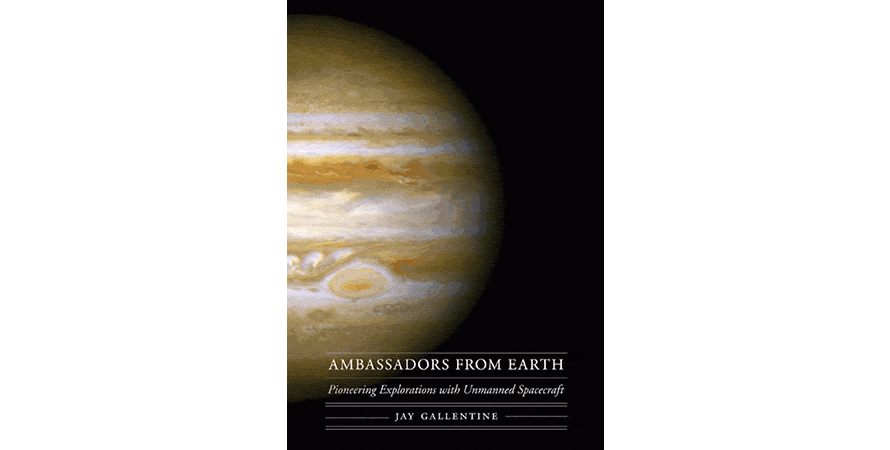Category: Nonfiction
Reviewed by: Clifford R. McMurray
Title: Ambassadors from Earth: Pioneering Explorations with Unmanned Spacecraft
Author: Jay Gallentine
NSS Amazon link for this book
Format: Paperback
Pages: 544
Publisher: University of Nebraska Press
Date: June 2014
Retail Price: $24.95
ISBN: 978-0803249233
Halfway through the book, Jay Gallentine neatly summarizes the public relations problem of his subject matter: the “conspicuous imbalance between manned and unmanned flight came down to glamour. Bathtub faucets had more allure than a space probe. People loved astronauts. Explorer 1 never signed an autograph. Life magazine wouldn’t be doing a write-up on what Ranger 3 did with free time on the weekends. Forget about it…. How can you be a fan of something that doesn’t even come back?” Several chapters later, he answers his own question. “Unmanned spacecraft might not have their flyboy jock heroes in the nifty suits—but, oh, could they snap the most breathtaking of pictures.”
Certainly it’s the pictures that we all remember and care about, whatever else by way of scientific knowledge our robotic explorers return. They are our binoculars, surveying territory on the other side of a valley too deep for us to cross yet. But by the time Gallentine has introduced you to the men and women on both sides of the Iron Curtain who built and flew them, you’ll care about the robots themselves as much as you ever cared about the astronauts. His storytelling leaves the reader with a series of indelible and intertwined mental images of men, machines, and moments.
Especially in the beginning, there were more failures than successes. Shed a tear for Sergei Korolev and his Russian engineers, who were victims of their early success with Sputnik 1. The Soviets were as surprised as anyone at the propaganda coup Sputnik handed them, and Premier Khrushchev’s reaction was simple: Give me more! So Korolev’s team was forced to commit to insanely ambitious schedules. They flogged their hastily-designed and -assembled probes off the pad, only to see them fall back to Earth or fail to leave orbit when their boosters—also thrown aloft with no testing—failed, or fall silent after a few weeks when the probes themselves proved inadequate. Their Mars 1 rocket might have sparked a nuclear war, breaking up on its way to orbit during the Cuban Missile Crisis. With all that, Korolev managed to score most of the firsts in the early years of the Space Race, including the first pictures of the far side of the Moon (the film aboard Luna 1 that shot those pictures was salvaged from a U.S. spy balloon that went down over Soviet territory, because Soviet film wasn’t good enough for the job).
The Soviets racked up almost all the space firsts until NASA started sending probes into interplanetary space. Beyond the Moon, the honors for every single first visit to another planet in the solar system fall to NASA’s scientists and engineers. There was amazing, unsung talent on both sides of the Iron Curtain. On the American side, Gallentine follows people like George Ludwig, a graduate student working for James Van Allen, whose exquisitely handcrafted miniature instruments were nestled into the first Explorer probes and discovered the radiation belts that bear the name of his teacher. At JPL, working independently and using different methods, Mike Minovitch and Gary Flandro discovered the serendipitous alignment of the outer planets that made possible the Grand Tour taken by the Voyager probes in the 1980s. Brilliant engineers like William Shipley and Charles Kohlhase worked for a decade before those probes launched to solve all the problems that would allow spacecraft to work for longer than any had ever worked before; mission manager John Casani got them on their way and without a pause went to work on the Galileo Jupiter orbiter.
There are so many other great stories in this book that it’s hard to stop telling you about them. It’s impossible to do justice to the epic scope of Ambassadors from Earth in a short review. What Tom Wolfe did for the astronauts in The Right Stuff, Gallentine does for robotic explorers in this wonderful book (and its equally marvelous sequel, Infinity Beckoned: Adventuring Through the Inner Solar System, 1969–1989). Reading his prose is pure delight; it sparkles. He throws off simile and metaphor like a cat shedding fur (a line he might have written himself). If there’s any criticism to be made of Gallentine, it’s that his writing is so much fun it almost distracts from the story he’s telling. Almost. It’s the people he writes about that you’ll remember after his storytelling only a happy memory. Carl Sagan said “Charley Kohlhase’s name should be as well known as Michael Jordan’s.” That will never happen, but Gallentine has done his best to be sure that the readers of this book don’t forget it.
© 2019 Clifford R. McMurray
Please use the NSS Amazon Link for all your book and other purchases. It helps NSS and does not cost you a cent! Bookmark this link for ALL your Amazon shopping!



















